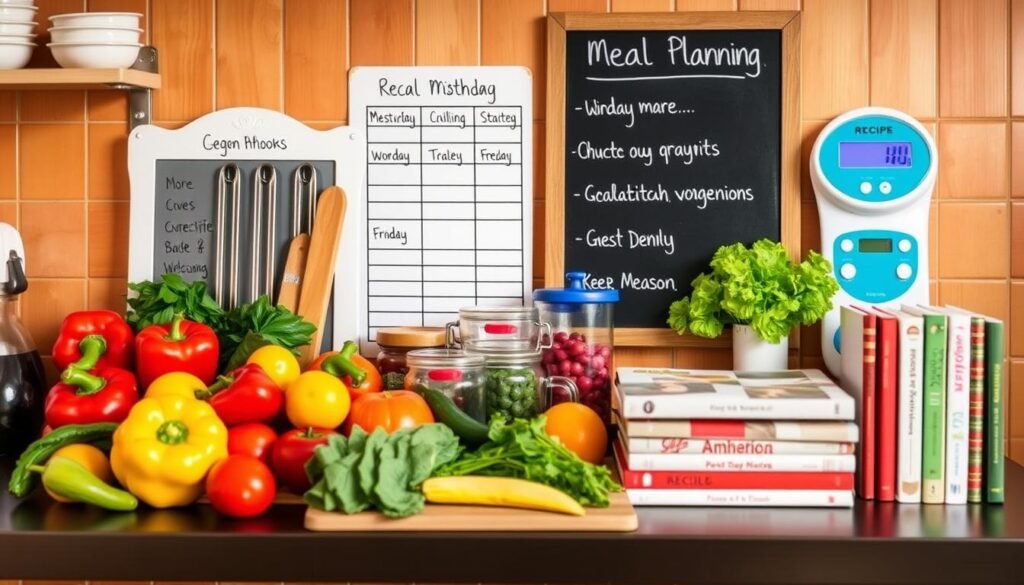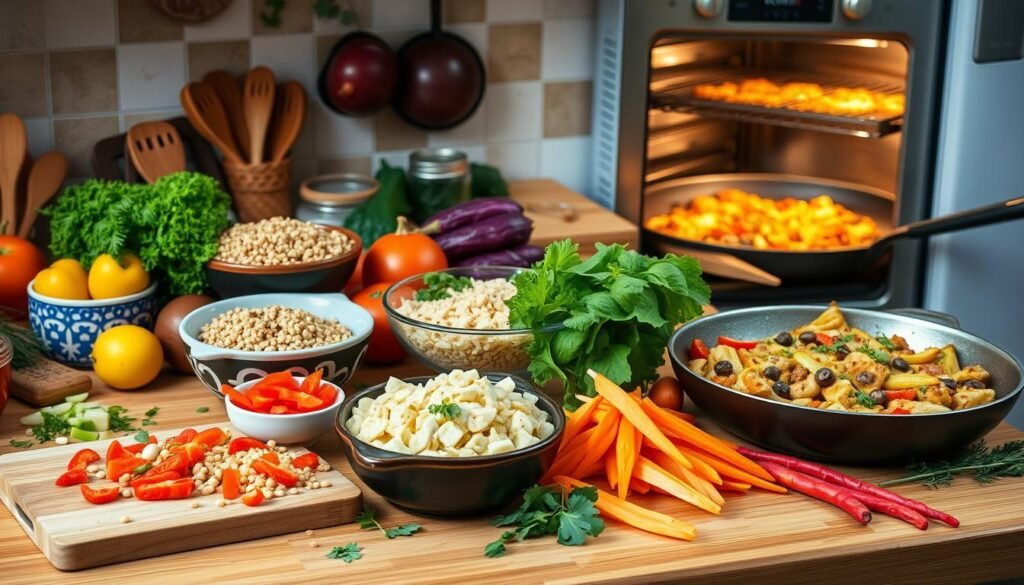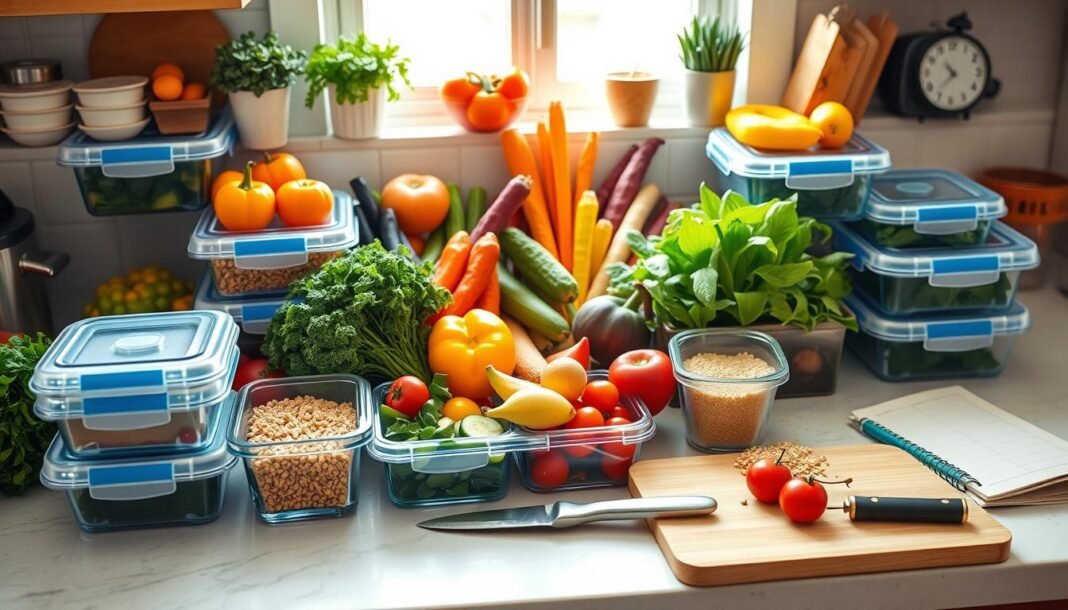Meal planning is key for a better diet and saving time in our fast world. It lets us focus on eating well and cutting down on wasted food. People who plan meals eat better and avoid fast food.
By organizing groceries and cooking steps, meal planning makes food prep simpler and more fun. It’s all about living healthier and enjoying the process of making meals.
Key Takeaways
- Meal planning helps save time during busy weekdays.
- Pre-planning meals encourages healthier food choices.
- Effective meal planning can reduce food waste significantly.
- Planning ahead streamlines grocery shopping experiences.
- Engaging in meal planning supports portion control.
- Incorporating seasonal ingredients enhances meal quality.
Understanding the Benefits of Meal Planning
Meal planning changes how we see food and cooking. It saves time and boosts the quality of our meals. Knowing these benefits can help more people start planning their meals.
Time Savings
Meal planning’s biggest benefit is saving time. Spending a bit of your week planning meals can avoid the daily “What’s for dinner?” question. This means you spend less time cooking on busy days. You’ll have more time for relaxation or family.
Improved Nutrition
Meal planning leads to better nutrition. It makes it easier to choose healthier meals ahead of time. You can add more whole foods and veggies to your diet. This method controls portion sizes and keeps eating habits healthy all week.
Reduced Food Waste
Meal planning also cuts down on food waste. By buying only what you need, you use up ingredients before they go bad. Nearly 40% of food in the U.S. gets wasted. Meal planning is a great step to reduce this waste.
| Benefit | Description |
|---|---|
| Time Savings | Planning meals ahead reduces daily cooking time and stress. |
| Improved Nutrition | Encourages healthy eating by allowing control over ingredients and portions. |
| Reduced Food Waste | Minimizes waste by ensuring ingredients are used before expiration. |
Creating Effective Grocery Lists
Making a good grocery list is key to planning your meals right. It makes shopping easier and ensures you don’t forget anything important. By organizing your items into categories, your grocery shopping becomes much more efficient.
How to Organize Your List
Sorting your list into different sections helps make your shopping trip quicker. It not only makes you faster but also helps you buy wisely. Here’s how you can better organize your list:
- List items in the order you encounter them in the store.
- Group similar items together.
- Include quantities needed for each ingredient.
- Leave space for additional items that may come to mind while shopping.
Seasonal Ingredients to Include
Using seasonal ingredients is smart. They’re fresher, cheaper, and tastier. Plus, they’re better for your health. When planning, think about adding these seasonal foods:
| Season | Fruits | Vegetables |
|---|---|---|
| Spring | Strawberries, Cherries | Asparagus, Peas |
| Summer | Watermelon, Blueberries | Corn, Zucchini |
| Fall | Apples, Pears | Squash, Sweet Potatoes |
| Winter | Oranges, Grapefruit | Kale, Brussels Sprouts |
Meal Planning: Strategies for Success
Meal planning can make your week much smoother and more fun. Setting up cooking goals that fit your life is key. You can pick meals that meet your schedule and what your family likes. This way, eating healthy becomes doable and long-lasting. If you are looking for the best Website, you can Visit here for more information: Puravive
Setting Realistic Goals
First, think about your week. How many meals can you make? Look at your activities and who you’re cooking for. Breaking cooking into small steps helps avoid stress. Having clear, doable goals helps make meal planning easier.
Weekly Menus and Cooking Schedules
Making a menu for the week makes cooking simpler. It also helps you eat various foods that are good for you. Plan cooking times to keep your week balanced. For example, cook a lot on weekends to make weekdays easier. With a good plan, you’ll save time and stress at meal times.

Recipe Management Tips
Managing recipes well is key to great meal planning. It can change how you cook. You can find many recipes to keep meals fun and fulfilling. A neat system keeps your food exciting.
Finding and Storing Recipes
Look for recipes in cookbooks, food blogs, and apps. These help you organize your kitchen life. With digital tools, you can sort and find recipes fast. This makes meal planning easier.
Incorporating Variety in Your Meals
Adding new foods makes eating fun and stops boredom. Try different foods, seasonal items, or new ways to cook. It improves your skills and leads to better eating habits. Your family will look forward to meals, making everyone healthier and happier.
Navigating Dietary Restrictions
Meal planning should meet individual dietary needs. It’s important to make sure everyone enjoys their meals. Knowing these needs is key to making personalized meal plans.
Identifying Specific Needs
Dietary restrictions vary widely. They may be due to allergies, health issues, or lifestyle choices. Some common restrictions are:
- Gluten intolerance
- Dairy allergies
- Vegan or vegetarian lifestyles
- Low-carb or keto diets
Customizing Meal Plans
To cater to these needs, meal plans have to be customized. This might mean changing ingredients or creating new recipes. By doing so, everyone’s tastes are considered while sticking to their diets.
| Diet Type | Restrictions | Sample Ingredients |
|---|---|---|
| Gluten-Free | No wheat, barley, or rye | Quinoa, rice, almond flour |
| Dairy-Free | No milk or dairy products | Coconut milk, almond cheese, nutritional yeast |
| Vegetarian | No meat or fish | Lentils, tofu, vegetables |
| Keto | Low carbohydrates | Avocados, eggs, leafy greens |
Making sure you know these restrictions makes meal planning easier. Personalized meals bring families together. They ensure diverse, enjoyable meals that fit everyone’s dietary rules.
Meal Prep Ideas to Simplify Your Week
Meal prep can change how you cook each week. It lets you eat healthier and lowers stress on busy days. By planning and cooking in batches, you have tasty, good-for-you food ready anytime. This means enjoying homemade meals without the daily work.
Batch Cooking Essentials
Batch cooking means making big amounts of food to split into single servings later. It saves time and keeps good food ready whenever. Use ingredients that work in many recipes, like:
- Whole grains like quinoa or brown rice
- Lean proteins such as chicken, turkey, or tofu
- Seasonal vegetables like bell peppers, broccoli, and carrots
Get into the habit of batch cooking to try new tastes and food types. Spend a few hours each week cooking your favorites this way.
Storage Solutions for Meal Prep
Choosing the right storage is key to keeping meals fresh. Look at these options:
| Storage Option | Best For | Benefits |
|---|---|---|
| Glass Containers | Fruits, grains, proteins | Microwave-safe, reusable, airtight |
| Mason Jars | Salads, dressings, overnight oats | Easy to store, transport, preserve freshness |
| Freezer Bags | Soups, stews, bulk proteins | Space-efficient, prevents freezer burn |
Label your containers to stay organized and find meals fast. With the right storage, enjoying your homemade food is easy.
Nutrition Tracking: Staying on Course
Nutrition tracking is key to reaching your meal planning goals. It helps you watch what you eat. This way, you can choose foods for a balanced diet. This leads to better health. Many people use meal monitoring apps for this.
Tools and Apps for Monitoring Meals
There are several apps to help you track your nutrition. These apps let you record your meals, check your macros, and understand your eating habits. Some well-known ones are:
- MyFitnessPal: Easy to use, with a huge database of foods.
- Cronometer: Great for those who want to track all nutrients in detail.
- Lose It!: It focuses on calories and lets you set goals for macros.
Understanding Nutritional Labels
Knowing about nutritional labels is important for meal planning. It helps you pick healthier food and know the right amounts to eat. Look for these key parts on the label:
| Label Component | Significance |
|---|---|
| Serving Size | Shows how much is one serving. This helps you keep track of calories. |
| Calories | Tells the energy in one serving. This is key to control your intake. |
| Macronutrients | Gives details on carbs, proteins, and fats for a balanced diet. |
| Sugars | Points out added sugars to help you make better choices. |
| Vitamins & Minerals | Shows how the food fits into your daily need for nutrients. |
Ingredient Substitutions for Flexibility
Getting to know ingredient substitutions can make cooking more flexible. These changes keep your meals true to their taste while making them healthier. This is handy whether you’re dealing with dietary limits or just want to make your food more nutritious.
Common Substitutions You Should Know
There are many common substitutes for kitchen staples that boost nutrition without losing flavor. Let’s look at some well-known swaps:
| Original Ingredient | Substitution | Benefits |
|---|---|---|
| Sour Cream | Greek Yogurt | Increase in protein and lower fat content |
| White Rice | Cauliflower Rice | Lower carb count and added fiber |
| Butter | Applesauce | Reduced calories and added nutrients |
| Vegetable Oil | Olive Oil | Healthier fats and antioxidants |
| Sugar | Honey or Maple Syrup | Natural sweetness with vitamins |
Adapting Recipes for Healthier Outcomes
It’s often simple to turn favorite recipes into healthier versions. Here’s how you can make adaptions:
- Reduce sugar to cut calories and bring out natural tastes.
- Swap unhealthy fats with better choices like avocado oil or nut butters.
- Incorporate more vegetables to boost fiber and nutrients.
- Use whole grain alternatives over refined grains.
Leftovers Management: Making the Most of What You Have
Managing leftovers well helps reduce food waste and gets the most out of meals. With a bit of planning and creativity, leftovers can turn into delicious new dishes. This practice saves time and resources, making it both rewarding and practical.
Creative Ways to Use Leftovers
Getting creative with leftovers can bring new flavors to your table. Here are some tasty ideas to prevent food waste:
- Turn leftover vegetables into a hearty stir-fry with some fresh seasonings and protein.
- Make a flavorful soup by simmering scraps with broth and spices.
- Create a salad using leftover grains and protein, topped with a zesty dressing.
- Stuff leftover meats into tacos or wraps for a quick and tasty meal.
- Incorporate remnants into pasta dishes for added flavor and texture.
Storage Tips for Long-Lasting Food
Knowing how to store food can keep it fresh and flavorful. Here are some tips to ensure your leftovers stay delicious:
- Label containers with the date and contents to keep track of what needs to be used first.
- Utilize vacuum-sealing for long-lasting storage, keeping food free from freezer burn.
- Store items in airtight containers to prevent spoilage and odors.
- Refrigerate or freeze leftovers promptly within two hours of cooking to maintain quality.

Conclusion
Meal planning is key to eating better and simplifying your life. It helps to make grocery shopping organized. Plus, you can pick healthy recipes that are easy to make. Doing this makes meals not just good for you but also fun to eat.
Using ideas like cooking lots at once and getting creative with leftovers cuts down on waste. It also keeps meals exciting. Whether you’re feeding just you or a whole family, these tips make eating together better.
Choosing to plan your meals is a big step towards being healthier. It makes cooking fun and easy. With good planning and the right attitude, improving your diet is simple and rewarding.










